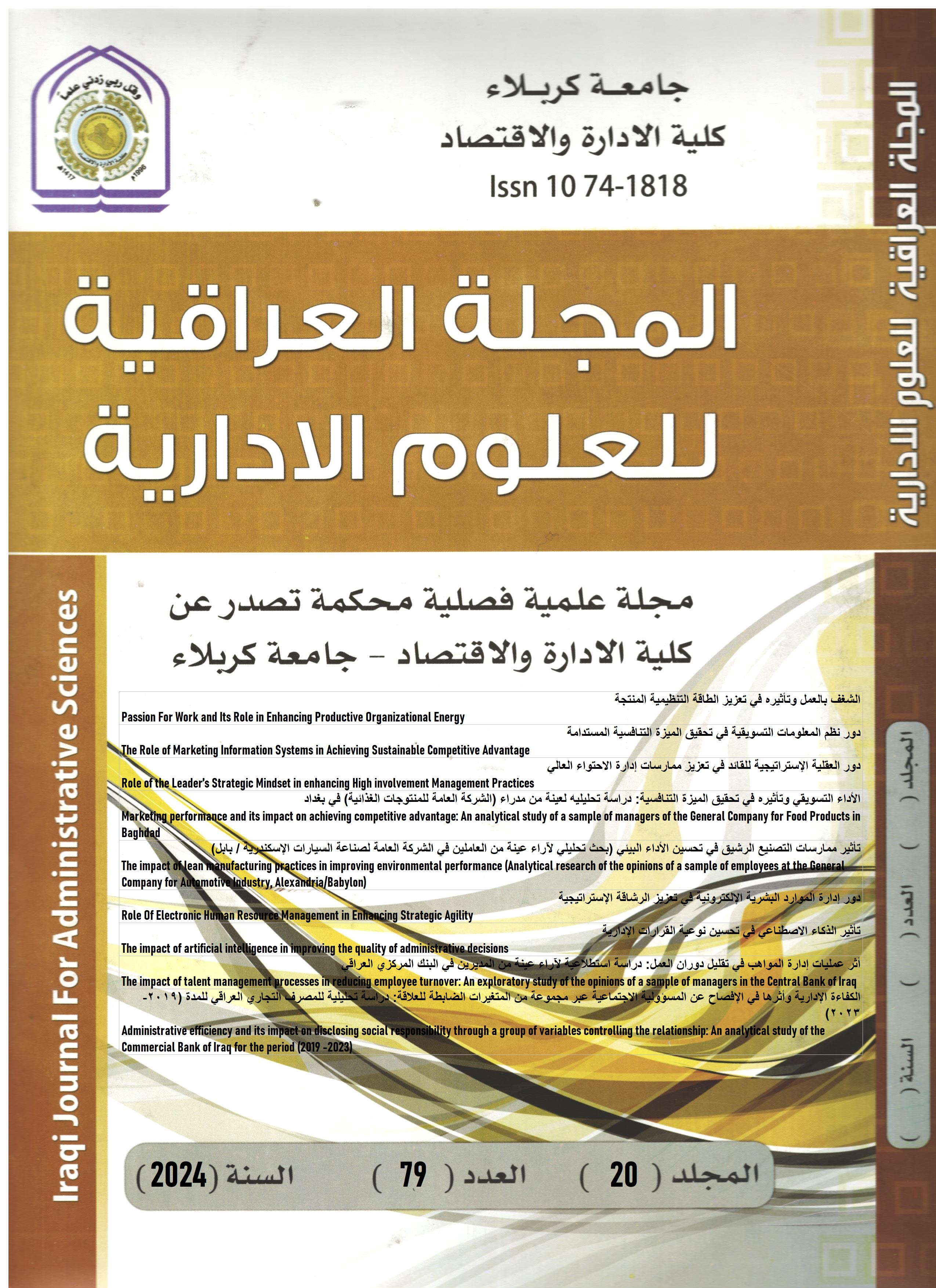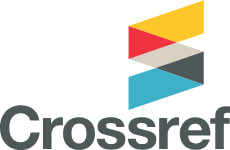Role of the Leader’s Strategic Mindset in enhancing High involvement Management Practices
Keywords:
Leader's Strategic Mindset, High involvement Management Practices, HIM, China Petroleum Pipeline Corporation, CPPAbstract
The study aimed to explore the role of the strategic mindset of leaders in enhancing high involvement management practices at the China Petroleum Pipeline(CPP)company in Basra Province. The strategic mindset of leaders was measured through three dimensions: systemic thinking, reframing,and reflection.The high involvement management practices were measured through four dimensions: empowerment, information sharing, development practices, and rewards. A questionnaire was used as the primary data collection tool, involving a sample of 200 employees (Iraqi, Arab, and foreign) in the studied company. the research yielded several results, with the most prominent being the existence of a significant positive relationship between the leader's strategic mindset variable and the high involvement management practices variable. The study recommended that the company's management increase its focus on the dimensions of the leader's strategic mindset, as it would enable them to achieve success and innovation in the organization's prosperity and growth in a highly competitive environment.
References
- الرفاعي، احمد حسين، (2014)، مناهج البحث العلمي – تطبيقات إدارية واقتصادية، الطبعة السابعة، دار وائل للطباعة والنشر والتوزيع، عمان، الأردن.
- عبد الفتاح، عز حسن، (2008)" مقدمة في الإحصاء الوصفي والاستدلالي باستخدام ((spss، الناشر دار الخوارزمي للطباعة والنشر.
- ناجي، هلة تركي، (2020)، الدور الوسيط لنظم العمل عالية الأداء بين إدارة الاحتواء العالي والريادة الإستراتيجية –بحث تطبيقي في شركة ديالى العامة للصناعات الكهربائية – رسالة ماجستير، كلية الإدارة والاقتصاد، جامعة بغداد.
ثانيا: المصادر الأجنبية
- A.N. Oppenheim" Questionnaire Design, Interviewing and Attitude Measurement" Continuum London And New York, New Edition,1992
- Akhigbe, O. J. (2020). High Involvement Management and Employee Performance of Deposit Money Banks in Rivers State. JournalNX, 6(08), 131-149.
- Arjona-Medina, J. A., Gillhofer, M., Widrich, M., Unterthiner, T., Brandstetter, J., & Hochreiter, S. (2019). Rudder: Return decomposition for delayed rewards. Advances in Neural Information Processing Systems, 32.
- Benson, G. S., & Lawler III, E. E. (2003). Employee involvement: Utilization, impacts, and future prospects. The new workplace: A guide to the human impact of modern working practices, 155-173.
- Bentvelzen, M., Woźniak, P. W., Herbes, P. S., Stefanidi, E., & Niess, J. (2022). Revisiting reflection in hci: Four design resources for technologies that support reflection. Proceedings of the ACM on Interactive, Mobile, Wearable and Ubiquitous Technologies, 6(1), 1-27.
- Bouhali, R., Mekdad, Y., Lebsir, H., & Ferkha, L. (2015). Leader roles for innovation: Strategic thinking and planning. Procedia-Social and Behavioral Sciences, 181, 72-78
- Cancey, P. Christine; Reidy, John (2007) (Statistics Without Maths for Psychology) Fourth edition, Pearson Prentice Hall.
- Chen, P., Powers, J. T., Katragadda, K. R., Cohen, G. L., & Dweck, C. S. (2020). A strategic mindset: An orientation toward strategic behavior during goal pursuit. Proceedings of the National Academy of Sciences, 117(25), 14066-14072.
- Chen, S., Ding, Y., & Liu, X. (2023). Development of the growth mindset scale: Evidence of structural validity, measurement model, direct and indirect effects in Chinese samples. Current Psychology, 42(3), 1712-1726.
- Dirani, K. M., Abadi, M., Alizadeh, A., Barhate, B., Garza, R. C., Gunasekara, N., ... & Majzun, Z. (2020). Leadership competencies and the essential role of human resource development in times of crisis: a response to Covid-19 pandemic. Human resource development international, 23(4), 380-394.
- Doucet, O., Lapalme, M. È., Simard, G., & Tremblay, M. (2015). High involvement management practices as leadership enhancers. International Journal of Manpower, 36(7), 1058-1071.
- Dweck, C. (2017). Mindset-updated edition: Changing the way you think to fulfil your potential. Hachette UK.
- Ewing, R. (2019). Best development practices: Doing the right thing and making money at the same time. Routledge.
- Goldman, E., Cahill, T., & Pessanha Filho, R. (2009). Experiences that develop the ability to think strategically. Journal of Healthcare Management, 54(6), 403-416.
- Gollan, P. J. (2005). High involvement management and human resource sustainability: The challenges and opportunities. Asia Pacific Journal of Human Resources, 43(1), 18-33.
- Gresham, J., Dibbs, P., & Berv, J. (2023). Mind The Mindset Gap,(1-10).
- Hadfield-Menell, D., Milli, S., Abbeel, P., Russell, S. J., & Dragan, A. (2017). Inverse reward design. Advances in neural information processing systems, 30,1-10.
- Hoogeboom, M. A., & Wilderom, C. P. (2020). A complex adaptive systems approach to real-life team interaction patterns, task context, information sharing, and effectiveness. Group & Organization Management, 45(1), 3-42.
- Ikhsannudin, M., & Pakpahan, P. L. (2021). Empowerment as A Quality Improvement Human Resources Through The Implementation of Total Quality Management. Nidhomul Haq: Jurnal Manajemen Pendidikan Islam, 6(1), 41-60.
- Jaaron, A. A., Pham, D. T., & Cogonon, M. E. (2023). Systems thinking to facilitate “double loop” learning in tourism industry: A COVID-19 response strategy. Journal of Sustainable Tourism, 31(4), 1032-1050.
- Kamariah, Najmi, Rahman, Abdul. & Kadir, Isa Ansari., (2018), Mediation effect of dynamic capability in the relationship between knowledge management and strategic leadership to organizational performance accountability, International Journal of Law and Ma
- Kasaya, M. A., & Munjuri, M. G. (2018). Effect of employee involvement on job performance in the medical research industry in Kenya. International journal of economics, commerce and management, 6(5), 826-847.
- Keren, H., O’Callaghan, G., Vidal-Ribas, P., Buzzell, G. A., Brotman, M. A., Leibenluft, E., ... & Stringaris, A. (2018). Reward processing in depression: a conceptual and meta-analytic review across fMRI and EEG studies. American Journal of Psychiatry, 175(11), 1111-1120.
- Kilroy, S., Flood, P. C., Bosak, J., & Chênevert, D. (2017). Perceptions of high‐involvement work practices, person‐organization fit, and burnout: a time‐lagged study of health care employees. Human Resource Management, 56(5), 821-835.
- Koliba, C., Wiltshire, S., Scheinert, S., Turner, D., Zia, A., & Campbell, E. (2017). The critical role of information sharing to the value proposition of a food systems network. Public Management Review, 19(3), 284-304.
- Le, T. T., & Le, P. B. (2023). High-involvement HRM practices stimulate incremental and radical innovation: The roles of knowledge sharing and market turbulence. Journal of Open Innovation: Technology, Market, and Complexity, 9(1), 100006.
- Lee, B. Y. (2021). Variations in Employee Training and Participation in the Taiwanese ICT Industry: An Institutional Logics Perspective (Doctoral dissertation, King's College London).
- Li, M., Khan, H. S. U. D., Chughtai, M. S., & Le, T. T. (2022). Innovation onset: A moderated mediation model of high-involvement work practices and employees' innovative work behavior. Psychology Research and Behavior Management, 471-490.
- Li, Y., Wang, M., Van Jaarsveld, D. D., Lee, G. K., & Ma, D. G. (2018). From employee-experienced high-involvement work system to innovation: An emergence-based human resource management framework. Academy of Management Journal, 61(5), 2000-2019.
- Liu, L., Bouman, T., Perlaviciute, G., & Steg, L. (2020). Public participation in decision making, perceived procedural fairness and public acceptability of renewable energy projects. Energy and Climate Change, 1, 100013.
- Mehmood, K., Iftikhar, Y., Khan, A. N., & Kwan, H. K. (2023). The Nexus Between High-Involvement Work Practices and Employees’ Proactive Behavior in Public Service Organizations: A Time-Lagged Moderated-Mediation Model. Psychology Research and Behavior Management, 1571-1586.
- Nuntamanop, P., Kauranen, I., & Igel, B. (2013). A new model of strategic thinking competency. Journal of Strategy and Management, 6(3), 242-264.
- Peutere, L., Saloniemi, A., Böckerman, P., Aho, S., Nätti, J., & Nummi, T. (2022). High-involvement management practices and the productivity of firms: Detecting industry heterogeneity. Economic and Industrial Democracy, 43(2), 853-876.
- Pisapia, J., Reyes-Guerra, D., & Coukos-Semmel, E. (2005). Developing the leader’s strategic mindset: Establishing the measures. Leadership Review, 5(1), 41-68.
- Pradhan, R. K., & Panda, M. (2021). Human resource empowerment: development and validation of a measurement tool. Global Business Review, 22(4), 1019-1037.
- Rigby, C. S., & Ryan, R. M. (2018). Self-determination theory in human resource development: New directions and practical considerations. Advances in Developing Human Resources, 20(2), 133-147.
- Shtulman, A., & Young, A. G. (2023). The development of cognitive reflection. Child Development Perspectives, 17(1), 59-66.
- Swanson, R. A. (2022). Foundations of human resource development. Berrett-Koehler Publishers.
- Switzer, M. (2008). Strategic thinking in fast growing organizations. Journal of Strategic Leadership, 1(1), 31-38.
- Talib, A. F., & Dhahad, Z. N. (2019). Management of High Involvement and Its Impact on the Reinforcement of Psychological Capital Analytical Study for a Sample of Faculty Members in Some Iraqi Universities and Colleges. Journal of University of Babylon for Pure and Applied Sciences, 27(3), 370-391.
- Thams, Y., Chacar, A., & Wiersema, M. (2020). Global strategic context and CEO appointments: The importance of a global mind‐set. Global Strategy Journal, 10(4), 676-699.
- Waseem, M., Ali, S., Bilal, H., & Khan, A. A. (2020). High involvement management practices and employees’ OCBs in banking sector of Pakistan. Journal of Accounting and Finance in Emerging Economies, 6(2), 529-538.
- Weisz, E., Ong, D. C., Carlson, R. W., & Zaki, J. (2021). Building empathy through motivation-based interventions. Emotion, 21(5), 990.
- Winkler, P., & Etter, M. (2018). Strategic communication and emergence: A dual narrative framework. International Journal of Strategic Communication, 12(4), 382-398.
- Wood, S., & de Menezes, L. M. (2008). Comparing perspectives on high involvement management and organizational performance across the British economy. The International Journal of Human Resource Management, 19(4), 639-683.
- Wood, S., & Ogbonnaya, C. (2018). High-involvement management, economic recession, well-being, and organizational performance. Journal of Management, 44(8), 3070-3095.
- Wood, S., Nolte, S., Burridge, M., Rudloff, D., & Green, W. (2015). Dimensions and location of high‐involvement management: fresh evidence from the UK C ommission's 2011 E mployer S kills S urvey. Human Resource Management Journal, 25(2), 166-183.
- Ziems, C., Li, M., Zhang, A., & Yang, D. (2022). Inducing positive perspectives with text reframing. arXiv preprint arXiv:2204.02952.
Downloads
Published
How to Cite
Issue
Section
License
Copyright (c) 2024 https://creativecommons.org/licenses/by-nc-nd/4.0

This work is licensed under a Creative Commons Attribution-NonCommercial-NoDerivatives 4.0 International License.
Authors retain the copyright of their papers without restrictions.










